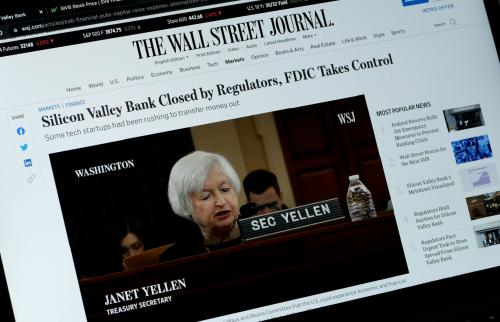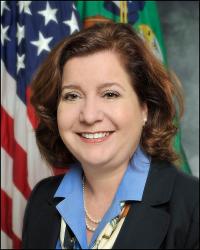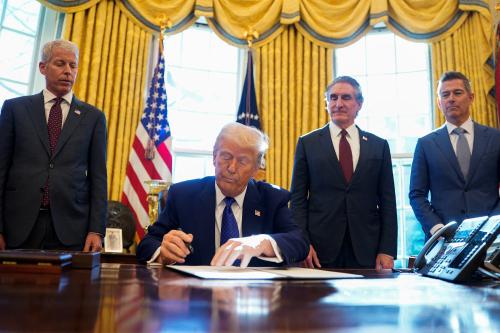As COVID-19 swept across the globe, many nations, including the U.S., struggled to define a cohesive public health strategy to prevent the spread of the disease. However, in spite of the lack of a clear plan, improvised strategies of behavioral changes—e.g., masking, social distancing—slowed transmission until a vaccine could be developed. The new BPEA paper, “The impact of vaccines and behaviors on U.S. cumulative deaths from COVID-19,” estimates that the ad hoc strategy prevented close to 800,000 deaths. On this episode of the Brookings Podcast on Economic Activity, paper co-author Stephen Kissler, an epidemiologist at the University of Colorado, Boulder, talks with Brookings Senior Fellow Carol Graham about the model they used to study COVID-19’s impacts and what can be done to improve the government response to future pandemics.
This is the final episode of season four of the podcast.
- Listen to the Brookings Podcast on Economic Activity on Apple, Spotify, or wherever you like to get podcasts.
- Learn about other Brookings podcasts from the Brookings Podcast Network.
- Sign up for the podcasts newsletter for occasional updates on featured episodes and new shows.
- Send feedback email to [email protected].
Transcript
[music]
EBERLY: I am Jan Eberly, the James R. and Helen D. Russell Professor of Finance at Northwestern University.
STEINSSON: And I’m Jón Steinsson, Chancellor’s Professor of Economics at the University of California, Berkeley.
EBERLY: We’re the coeditors of the Brookings Papers on Economic Activity, a semiannual academic conference and journal that pairs rigorous research and real time policy analysis to address the most urgent economic challenges of the day.
STEINSSON: And this is the Brookings Podcast on Economic Activity, where we share conversations with leading economists on the research they do and how it will affect economic policy.
EBERLY: It’s been over four years since COVID-19 first appeared and had a wide impact on behavior in the United States and the world. A new study, which will be discussed on today’s episode, presents a new model looking at the efficacy of the U.S. response and lessons to be learned for future public health crises. Andrew Atkeson of the University of California, Los Angeles, and Steven Kessler of the University of Colorado, Boulder, are the authors of the new paper, “The Impact of Vaccines and Behavior on U.S. Cumulative Deaths from COVID-19.”
STEINSSON: I really enjoyed reading this paper. The policy discussion about COVID was so overwhelming at times while the pandemic was ongoing. I think many people felt a bit saturated at some point, but now that the world is increasingly getting back to normal, perhaps a new normal, and some time has passed for evidence the buildup regarding the pandemic, I found it really interesting to read such a big picture paper about the episode.
One result in particular stood out to me. This was the really strong behavioral response of people to the pandemic. The authors discuss how this strong behavioral response allowed 80% of the U.S. population over the age of 65 to avoid contracting the virus before being vaccinated. My understanding is prior to COVID, many epidemiologists were skeptical that behavioral responses of this magnitude were possible.
EBERLY: Given the vulnerability of seniors to COVID, that behavioral response was important to public health and further transmission. Looking forward, it raises the question of what to prioritize when a new infectious disease appears, since even the best prepared cannot do everything everywhere all at once. The paper suggests that for COVID, reducing exposures until vaccines were available was crucial.
STEINSSON: Yes, that’s right. But it also highlights both fatigue and the behavioral response over time. And the notion that the delta and omicron variants were just much harder to guard against. So, the speed with which the vaccines were developed was critical. Let’s pass it off to Brookings Senior Fellow Carol Graham interviewing Stephen Kissler to hear more about this fascinating paper.
GRAHAM: So, thank you Jón and Jan. And hello, Stephen. Welcome to the Brookings Podcast.
KISSLER: Thank you so much for having me. I’m really excited to be here.
GRAHAM: Yeah, of course. You did a great job on this paper. It was a pleasure to be at the session and to hear it there. So, let me just start with a very simple thing. I found the model impressive and obviously had some really interesting and positive results. But I think for our listeners who are probably most of them are not academic economists or public health experts, I was hoping you might summarize the key assumptions and the parameters of the data you use. Just explain a little bit how it works.
[3:49]
KISSLER: Absolutely. Yeah. So, we tried to accomplish a couple of things with the model. Ultimately, the model was intended to account for COVID-19-related mortality in the United States. So, that was the key data that we used to inform the model. But in addition to that, we were interested in how both behavior and vaccination impacted the ultimate course of mortality in the United States. And so, we needed information on both vaccine uptake—so, how many people had been vaccinated in the United States over time—and also how much immunity there was in the population, either through vaccination or through previous infection.
And so, that was a really interesting data set that ended up being really critical to our results. And it came from a couple of different places. One was from blood donors, and one was from people who were essentially undergoing medical procedures and had their blood drawn for any reason. And those two data sets allowed researchers to essentially measure antibodies to COVID-19, and to see whether or not you had immunity and even to some extent the type of immunity you had, meaning whether you had gotten it through infection or through vaccination. So, that allowed us to start to disentangle the effect of vaccination and previous infection on the ultimate amount of mortality in the United States.
[5:06]
So, using those data, we did a couple of calculations. My background and training is mainly in the epidemiology side. I got to work with an economist on this paper as well, Andy Atkeson. It was really great collaboration. And through that collaboration, you’re right, we developed a model that was both epidemiological and economic, or behavioral, in some sense, and really trying to understand the interplay between those two things.
It’s really difficult to capture behavior in a mathematical model. We humans are pretty complex critters, and that can make it really challenging to write down mathematical equations that capture our behavior. But one of the really key insights that economics has to offer for these types of models is the recognition that people do change their behavior in response to things like perceived risk, and in response to an understanding of what the people around them might be doing.
So, one of the things that we did in this model was included a very simple mathematical equation essentially describing how we expect people might have responded to the amount of mortality that was happening in their communities. And that adjusted their behavior, made them more likely to do all the sorts of things that we know can protect against infection, whether that be mask wearing, or staying at home, or all these different kinds of things. And it turns out that if you do account for that behavioral response to the amount of mortality in your community, you can actually do a very good job of really recapturing the course of mortality in the United States over time.
GRAHAM: That’s really helpful. And it actually naturally leads to my next question, which is, I’m wondering if you think of your model as a combination of both or one more than the other? For example, you find that death rates decline dramatically in the latter wave of COVID when people had more information, obviously, on how other people were doing, were they’re dying, what their community was doing. And you say that their behavior changed by either being vaccinated or being infected. And given the blood sample work and data you all have, which dominated in terms of the effects? Was it the behavioral effects or was it just infection rates, or did that vary across states?
[7:14]
KISSLER: Yeah. So, it did vary some across states. But one of the things that was really most striking to us was actually how similar the behavioral response appeared to be across states, especially after the first initial major wave of infections in New York City. So, it seems that uniformly across states, at least according to the model and the analysis that we did, people all across the United States, in every state, really radically changed their behavior. Now, of course, there were differences between states, even differences within states of how people responded. But by and large, there’s very strong evidence of a strong behavioral response.
Now, it’s really difficult to disentangle the impact of that behavioral response of reducing the number of infections that happened, especially early in the pandemic, from the ultimate impact, for example, of vaccination. And it’d be really nice to be able to cleanly separate out and say that behavior was responsible for this much of a reduction in mortality, and vaccination was responsible for this much of a reduction in mortality. And we can do that to some extent using the model.
[8:15]
But I think the most important thing, and the point here was most informative to me when I saw the results of this analysis, was that we really needed both together to achieve this major reduction in mortality. If there had been no change in behavior, we would have suffered an immense wave of infections and mortality very early in the pandemic. And that was a time when we didn’t know a lot about the virus, about how to treat it. And so, the mortality rate would have been exceptionally high. And so, we needed behavior to blunt that initial curve and to really buy us time until the vaccine could come.
But on the other hand, if we had engaged in the same kind of behavioral response that we did early in the pandemic, but vaccines had never come around, certainly the behavioral adjustment would have helped, but we would have been in a much worse situation, again, because with waning immunity with the evolution of the virus essentially everyone would have ended up infected at some point anyway and would not have had that protection from vaccination.
So, it’s really difficult to disentangle the value of behavior versus vaccines because we really, really needed both together to help achieve this reduction in mortality.
GRAHAM: You cite an estimate of about 800,000 deaths that were prevented by this combination. That’s a lot of people. So, again, it’s quite impressive.
Kind of related to that, to the extent there were state level differences, were they driven more by the usual differences in things like weather, air quality, health infrastructure, or by differences in responses to policies like getting vaccinated or wearing masks? They’re kind of different things, right? One is more in your control, and one is just … is what it is. And I’m wondering if you have any sense of that, particularly even if it’s not in the model as an epidemiologist.
[9:58]
KISSLER: Right. Yeah. You know, this is the million-dollar question. And I mean that because if we could figure this out, it could really help us to disentangle how much control we have over these kinds of differences and how much we don’t. The model that we used for this analysis wasn’t able to distinguish between those types of impacts. And in general, it’s a really difficult problem because all of these different factors were playing together at the same time. We were all in the midst of the pandemic simultaneously.
And so, it’s really hard to compare in a very controlled, scientific way one state versus another, and to attribute the differences in things like mortality to some specific difference between those two states. It’s something that we as epidemiologists are really continuing to work on, and there have been some really creative approaches to this, but I would say that we still haven’t really come up with a firm conclusion yet.
GRAHAM: Does the blood sample data allow for any bit of a look into it? In other words, you know, I imagine by state the percent of people infected and the percent of people vaccinated, I imagine that varied somewhat across states. Again, please tell me if I’m wrong. If that’s the case, could you maybe not model that, but get some empirical results on that?
[11:15]
KISSLER: You absolutely can. And you’re right. The serology data really does show pretty clearly that different states had, as you can imagine, different rates of vaccine uptake, different levels of infection at different points in time. And, you know, that varied across age groups for sure. I think in theory the serological data could absolutely give us that kind of information.
But I think that this gets to one of the other really key points that we make in the paper is that the data that we do have is not nearly detailed enough and isn’t really structured in the way that we would really want it to be in order to answer these questions in a principled way.
And so, we really need to invest in that data collection infrastructure, really understanding how people’s behavior changed at a really granular level, how people respond to risk. And some of the epidemiological surveillance where we’re actually collecting this kind of serological data. We’re very carefully tracking infections over time in different places. So, much of this data is reported at the state level, including the serological data. And so, we can compare across states.
But having only 50 points of comparison is great, but oftentimes still doesn’t give you enough statistical power to really make the kinds of conclusions you would want to. Having data at the county level, neighborhood level even would really help a lot with that kind of thing.
GRAHAM: You keep reaching my next question with your answer. So, this is kind of a pain of a question because I know it’s hard to get and it’s this idea of county level data, because there are just such big differences in mortality rates and in vaccination rates across counties, within states. I’ve been working on some different work but using some of the same data on the links between despair and misinformation, deaths of despair, the vulnerability to misinformation. But one of the variables that we use as a proxy for trust in health science and science more generally are county-level COVID vaccination rates. And so, what we find is that counties can be next to each other and have incredibly different vaccination rates, and typically places with lower vaccination rates also have lower compliance with things like mask wearing.
And again, I know this is difficult to do, not so much coming from your model but from your experience as an epidemiologist. Can you explain a bit more for our audience how these big differences across counties within states make a difference? But then also, given that those differences exist more in some states than others, how did the pattern still aggregate out to pretty much homogeneity across state level outcomes?
[13:53]
KISSLER: Yeah. So, this is a great question. And I think that there are a few different ways to be interested to at least begin to address it. But I think most importantly, this is just such a critical point in public health, and in any kind of economic or demographic studies is that there’s so much variability at such fine geographic scales that it can be really difficult to account for. This is borne out in a lot of the other research that I’ve done. And I think also just aligns with our own intuition in our own communities. We see a huge amount of structural disparities. We see a lot of behavioral differences. We see a lot of even just differences in living conditions from one community to the next. All of that contributes to variation in the spread of disease.
You asked a question about what kind of an impact the county level variation might have on disease dynamics. And the impact can be really profound. And one of the examples that we might all be familiar with that I often like to bring up with this is things like measles vaccination. So, you need a very high level of vaccination across the population to prevent a measles outbreak from happening. And on average, across the country, we have that level of vaccination. And yet we can still see measles outbreaks happening because in some specific communities, vaccine rates are low enough that the virus can gain a foothold.
[15:08]
Now, measles is an extremely infectious virus, and so, you really don’t have to have that vaccination rate dip too low for a major measles outbreak to become possible. But the same principle holds for every other infectious disease as well, where different communities that may have lower rates of immunity early in the pandemic, that might have meant lower rates of vaccination, for example, they can sort of contribute to the spread of infection in a way that you might not anticipate if you just sort of took this bird’s eye view of this average of sort of what’s going on across the state. It’s really important to have that kind of very detailed information, because it can really have a profound impact on disease dynamics.
GRAHAM: Well, that’s a great answer and again highlights the complexity of getting at this. One thing that’s really interesting to me, having looked a little bit at this stuff, is that the rising trend in declining measles vaccines seems to happen in areas that are coastal, considered elite, wealthy, educated by vaccine skeptics and the autism myth, I would say. But yet the COVID vaccination rates play out differently. They play out more, unfortunately, in part due to political ideology, in part due to skepticism about the trustworthiness of the medical system. But either/or are not good things, as you know better than anyone. And I’m wondering if, in your experience, you’ve seen the trend … I know for a while the measles skepticism was pretty high and we started having a lot of measles outbreaks. Has that continued or is it tapered off a bit?
[16:43]
KISSLER: Yeah. So, you’re absolutely right about the vaccine hesitancy and lower rates of vaccination, especially prior to the COVID pandemic. My mental model of who was most likely to be unvaccinated was exactly that—coastal elite communities. And you’re right, there has been a really big shift, and I think that we’re learning a lot about the behavior of vaccination now, too, and recognizing that it can be on a vaccine-by-vaccine basis. And it’s just so deeply embedded in the political and cultural milieu of the time, and even just some of the specifics of the ways that the vaccines were developed and our scientific experience with them, all of these things can really contribute to what makes a person more or less likely to be vaccinated.
The COVID pandemic has interestingly affected the transmission of basically every other infectious disease as well, including measles. And so, we saw some pretty large measles, you know, relatively large relative to measles outbreaks that we’d seen previously in the United States right up until 2020. And things did die down a little bit in 2020, in part because of all of the precautions that we were taking to prevent the spread of COVID. And you see this with flu, you see this with RSV, you see this with a number of other pathogens as well, that really the transmission rates seems to die down quite a bit during the pandemic.
GRAHAM: How about the willingness to get vaccinated rate? Does that change?
[18:06]
KISSLER: So, I think the relationship there is just a lot more complex. I think that it drove it up for some people and probably drove it down for others. I think that we’re starting to see more general vaccine hesitancy amongst communities where we didn’t see it prior to the pandemic. So, that’s definitely concerning that the groups that may be more likely to be unvaccinated against measles are in some ways growing, expanding into other groups or another geographic regions.
But I think that that’s also something that is really difficult to get information on, and it’s going to be difficult to see what the trends are going to be over time. You think, for example, of measles—I was vaccinated against measles when I was pretty young, and so, a lot of the information that we have about vaccine sentiment really comes from pediatric vaccinations. And it’s going to take a while just for enough new children to be born and to see whether or not their parents elect to have them vaccinated to really understand what the impact is of the COVID pandemic on vaccine trends in the United States.
GRAHAM: It would be tragic if more people don’t vaccinate their kids against measles, because there’s a point at which it really will affect the overall transmission rate, right?
KISSLER: Absolutely. I think that would be really tragic. I hope that it doesn’t happen, but I’m concerned that it might.
GRAHAM: One other question related to vaccination. And then maybe we can just do a few last thoughts on what your conclusions are, main ideas from the paper, and where you’re going next. But the last vaccination related question is with the boosters and the newest ones, the take up rate even in places with high vaccination rates, it’s still pretty low as COVID has become like a common cold. People think of it as a common cold, but yet it’s not really. And not if you’re old, right? Or have any other underlying conditions. So, is that just going to keep going down, do you think?
Or and I’m just wondering, because it just seems really not that hard to get vaccinated. And you don’t just protect yourself, you protect other people. But at least as far as I can tell, the latest boosters the take up rate is much lower than the other versions of the vaccine when, as you note in your paper, concern about COVID death was very high. Right?
[20:13]
KISSLER: Right. I think that this is an area where some economic theory can also contribute and certainly has already to some extent, too, to a large extent, in really thinking about what is it that encourages people to get vaccinated. Early in the pandemic there was just this huge incentive to be vaccinated, at least from my point of view, just because of how much of a reduction in severe disease and risk of mortality that you had if you went from being totally uninfected and unvaccinated to having that vaccine, the reduction in risk was just absolutely huge. And so, I think that simple argument …
GRAHAM: The fear of COVID was also very, very high then.
[20:50]
KISSLER: Right. Right. And, you know, rightly so. Because at this point, the vast majority of people have either been infected already or have received multiple vaccine doses or probably both. That’s certainly the case for me. I’ve had COVID and I’ve also been vaccinated multiple times. And so, in that sense, it makes some sense to me that uptake would be lower because it is true that the marginal benefit, the additional benefit that you get now, getting an additional booster, is smaller than the relative benefit you got early in the pandemic. And that’s because of how much immunity has been built up.
But I don’t think that vaccination rates are going to go to zero here. And I think that we can look to plenty of other infections, including flu, which is really been a really instructive case study for us as we’ve been thinking about COVID, where annual vaccination rates for flu in some age groups are, you know, as low as 50%, maybe 60%, but people do still keep getting vaccinated against flu. And that’s and that’s a very good thing.
And so, I think it’s unrealistic to think that everyone will be boosted annually for COVID, but I’m glad that the boosters exist, especially for the highest risk groups. I encourage people to get vaccinated whenever they’re eligible, and I think that we’d reach some sort of plateau where we reach sort of a steady vaccination rate for people against COVID-19. And I think that’s probably what we’ll be dealing with going forward. And that is already enough to make a big impact, even if higher rates might be better.
GRAHAM: That’s really helpful. Thank you. One last question with two parts, which is one, do you all plan to go further with this model and try and refine it more? And two, what are sort of the broader implications of what you found, what you did for your next stages in terms of your own work?
[22:30]
KISSLER: So, for your first question, we would love to take this model further. I think that it has a lot of potential, and I think that the most obvious location where we could really make some improvements to this model is in the behavioral aspect of it. Right now, the behavioral model is pretty simple. It’s a pretty simple accounting for the ways that a person’s behavior changes with respect to perceived risk. But there’s so much information from psychological literature and other places on how people do respond to risk that I think that we could incorporate a much more nuanced behavioral model that would hopefully then allow us to take that step from accounting for national mortality to accounting for state level mortality and sub state level mortality, which is something that we really haven’t gotten the model to do yet.
GRAHAM: That would be very cool. I’m a behavioral economist, so.
KISSLER: Amazing. Yeah, well, maybe we should talk more.
GRAHAM: And how about for next steps for your own work in the epidemiology area?
[23:29]
KISSLER: So, for me, one of the most important things that this model has helped me to think through is what kinds of things we need to be better prepared for the next pandemic. So, I think that there are absolutely improvements to this model that I would love to help to make, to make it more epidemiologically realistic and to incorporate more different types of data. But I think there’s always this risk of sort of fighting the last fire or, you know, fighting the last pandemic and recognizing that the next one could look awfully different to this one.
So, really, what I’m excited to do is to take a step back, to look at this model and other models like it, ways that people have really tried to account for how behavior and vaccination and all of these different types of things we can do to prevent the spread of disease worked during COVID, and to think about what kinds of things do we need to have in place for the next one. What kinds of models should we have built? What kinds of data should we have collected? What kinds of scenarios should we have thought through so that the next time around we can be a little bit more agile, a little bit more targeted, a little bit more flexible, and hopefully a lot more effective at controlling the spread of disease?
I think we’re going to have to think about that incredibly creatively, broadly, just because nature has a way of throwing all sorts of different kinds of threats at us. And so, it’s going to be a really imaginative process, and one that I hope to collaborate a lot with economists and virologists and clinicians, just to make sure that we’re prepared for whatever comes our way.
[music]
GRAHAM: That’s a great effort. It’s a great paper. And thank you very much.
KISSLER: Thank you so much for having me.
STEINSSON: Once again, I’m Jón Steinsson.
EBERLY: And I’m Jan Eberly.
STEINSSON: And this has been season four of the Brookings Podcast on Economic Activity. Thanks to our guest for this conversation, as well as a big thanks to all the BPEA authors and Brookings experts who joined the podcast this season. Be sure to subscribe to get notifications when we launch season five, which will be in October.
Thanks to the team that makes this podcast possible, including Kuwilileni Hauwanga, supervising producer; Fred Dews, producer; Gastón Reboredo, audio engineer; with support from Shannon Meraw and Chris Miller in Economic studies at Brookings. Show art was designed by Katie Merris at Brookings, and promotional support comes from our colleagues in Brookings Communications.
The Brookings Institution is committed to quality, independence, and impact.
We are supported by a diverse array of funders. In line with our values and policies, each Brookings publication represents the sole views of its author(s).










Commentary
PodcastDid behavioral changes reduce COVID-19 deaths?
Listen on
Brookings Podcast on Economic Activity
June 20, 2024